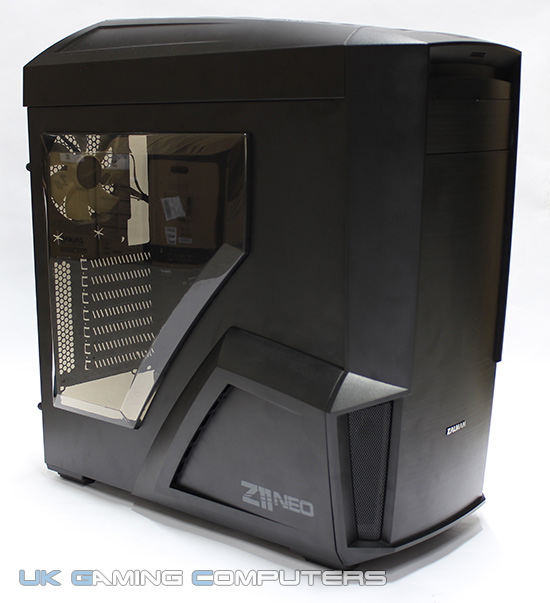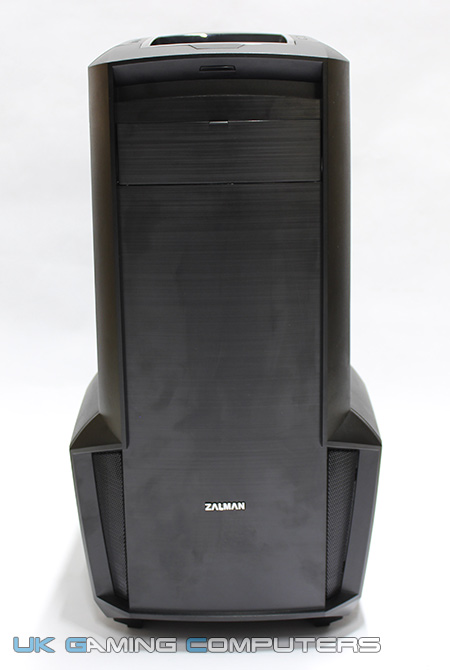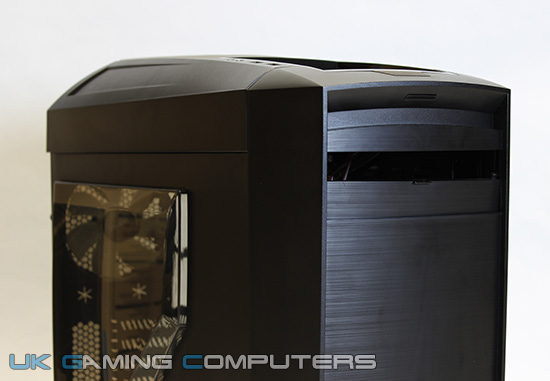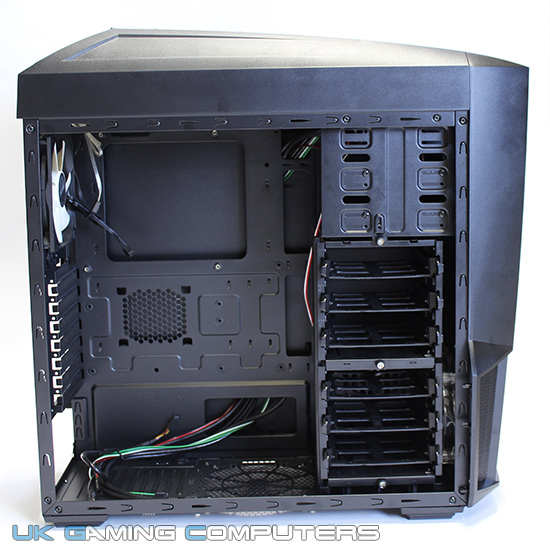Here at UK Gaming Computers we recently got hold of the new case from Zalman in their Z11 range – The Z11 Neo. Having quiet liked the value for money you can get from Zalman’s previous offerings, we were eager to get a look at the case and see how it matched up to one of its predecessors and one of our best selling cases the Zalman Z11 Plus.
The case is modestly priced around the £60.00 inc VAT mark which makes it a bit more expensive than the Z11 Plus, though it still seems a reasonable price for a mid size PC cases. From the spec sheet we were pleased to see the usually things you would expect from any case today, USB 3.0 support, dust filters, plenty of hard drive space and room for extra fans, however we really wanted to see what sets this case apart from Zalman’s previous cases.
Once the case arrived we found the standard Zalman packaging we’ve come to expect, a brown box with the make and model on the side and further specifications in smaller print, so far nothing too exciting. Inside the box you have the case wrapped in a plastic bag, support by the usual foam inserts. You also get the usual accessories in a nice clear plastic bag with the Zalman name on it and – a user’s manual, some cable ties, various different screws, a single PCI expansion slot cover and a CPU power cord extension.
After un-boxing, we got our first close up look at the Z11 Neo. Our initial impressions were that we quite liked the new styling of the case, which is similar in design to the existing Z11 range, but with a sleeker more dynamic look to the case. You get the same front panel connections as on the Z11 Plus, side window and protruding vents in both side panels, but with some changes, as the side window is a fair bit bigger than the one on the Z11 Plus, showing off more of the internals, whilst the protruding vents in the side panels are now less prominent.

One of the biggest differences between the existing Z11 range and the Z11 Neo, which adds to its new sleeker look, is at the front of the case. This now has a smooth brushed aluminium look with a ‘One-touch Sliding ODD door’ to access the top optical disk drive bay. Initially we thought this looks better than the mesh and grill front of the Z11 Plus, though it soon became clear that it’s not without some drawbacks. To start with the front it is still made from plastic, which probably explains why the one touch mechanism for the bay is quiet flimsy and unfortunately feels cheap. We were also concerned about airflow into the case as the front fan or fans are now hidden behind a solid plastic front, though the vents in the side panels should allow some air to get into the case.

The other big downside to the new front of the case is obviously the ODD door as this now limits you to just one optical drive, as the other two drive bays are now hidden. Whilst most people don’t need more than one optical drive (some even go without now!) the single optical drive bay means that you are limited in what extras, if any, you can add to your case. We always like to be able to add a nice flashy fan controller or card reader to the front of the case, or even have a nice water cooling reservoir shown off on the front of your PC, but with this single door, you simply can’t add any of these and still have your trusty optical drive in place.

On top of the case you have an almost identical layout to the rest of the Z11 range, two USB 2.0 ports on the left with headphone and microphone sockets and two USB 3.0 ports on the right with a reset button and between them a nice shiny tray for putting your phones/keys etc. The only real difference is that the HDD activity led has now moved to sit below the power button and above the optical disk drive door. Further back you also have the same vented fins as on other Z11 cases to allow good airflow out of the case.
The case is equipped with five fans for cooling, two blue led 120mm fans come as standard, along with one plain 120mm fan and two 80mm fans.
The first of the blue led fans is positioned at the front of the case, with mounts for a further 120mm fan to installed above it, though as this fan would be behind the solid plastic front of the Z11 Neo it would have very little affect on airflow. There is also a dust filter in front of these two fan placing’s.
Another area were we felt Zalman have got their design wrong is with the two 80mm fans, these are installed as exhaust fans in each of the side panels and is the same for all the Z11 models. The problem we have with this is that they are situated at the same level as the front fan just a little further back. This means that some of the fresh cool air being pushed into the case at the front is then immediately dumped back outside the case.
The plain 120mm fan is installed at the back of the case as an exhaust fan and the other 120mm led fan is installed in the top of the case, again as an exhaust fan. In addition you can fit another 120mm fan to the roof of the case, or if so inclined you could actually fit two 140mm fans instead, as there are mounts for both 120mm and 140mm fans. There is also plenty of space in the top of the case, so much that you can actual fit in a 240mm or possibly even a 280mm water cooling radiator! We’re not talking about a small all enclosed radiator either, we’re talking a full sized radiator for a full water cooling loop, something we were very impressed with. This is something the original Z11 and Z11 plus lacked.
Finally for fans you can fit another 120mm fan to the bottom of the case next to the power supply unit, this and the air intake for the power supply unit are both covered by dust filters, though strangely, Zalman have decide to have a dust filter for each, when one sliding dust filter for both would have been more practical.

Inside the Z11 Neo, you have plenty of room to work and the case will comfortable fit a full size ATX motherboard and a good sized graphics card. There is a nice large cut out on the motherboard try, for easily installation of a CPU cooler back plate; there is also plenty of room behind the motherboard tray for cable management, along with a mount for a 2.5” drive. On looking inside in the top right, you can see the optical drive bay and below that you can also see mounts for another two 2.5” drives or 3.5” drives in the two optical disk drive bays that are now hidden behind the front of the Z11 neo. These along with two hard drive bays that will fit either three 2.5” drives or three 3.5” drives each mean you could fit a total of up to 10 3.5” drives or 11 2.5” drives, which is probably more than enough for most users.
Another new feature of the Z11 Neo is that the two hard drive bays can now both be removed along with the supporting post. Whilst this is a nice little feature common on a lot of more expensive cases, it only seems to be of use here if you want to fit a rather gigantic graphics card or if you are going to modify the case to add a photon for water cooling, though as Zalman have blocked up the front of the case, fixing a tube reservoir may be a good idea if you want to go down the water-cooling route. We did wonder if you could fit another radiator for water cooling in the front of the PC, though as none of the 240mm radiators we had to hand fitted, we’re not sure this is going to be viable without further modification.
We should also make a couple of points about the build quality of the internals; the hard drive trays are quite flimsy and flex a lot, they don’t feel very secure and we would be concerned about transporting the case safely with any hard drives installed. Zalman have also persisted with the use of disposable PCI expansion slot covers, which is a common feature across their range of case. These feel cheap and it’s worrying how the non-removal parts of the case flex, when you are removing these PCI expansion slot covers.
Testing
As we’ve pointed out the rather strange choice of exhaust fans in the side panels, we thought it best to actually test the system to see if the orientation of these fans would make any difference to the temperatures in the PC, we therefore installed in the rig the follow items;
Gigabyte Z97-HD3 Motherboard
Intel Core i5 4690K
Stock CPU Cooler
8GB Corsair XMS3 1600MHZ RAM
Nvidia GTX 960 Graphics Card
Corsair CX500 PSU
500GB Seagate Barracuda HDD
Asus Optical Drive
Room ambient Temperature 22°C
For the initial tests we left the fans in the side panels in their original configuration, exhausting air from the PC. We then proceeded to run a few tests to check the temperatures of two of the main components in any gaming PC, the CPU and the graphics card.
Using Core Temp, we checked the CPU temperature when idle, which was hovering between 36 and 38°C, we then ran Prime 95 for 20 minutes to place the CPU under load, the maximum temperature recorded here was 77°C.
After the PC had been left for half an hour, so that the temperatures could return to normal, we then proceeded to check the graphics card temperature when idle using GPU-Z, this was around 33 to 36°C. Using Furmark to test the graphics card temperatures, again running it for 20 minutes, we got a maximum temperature of 79°C.
After swapping the fans over so that they would now work as intake fans – quite an easy job thanks to the way the side panels are designed – we then proceeded with the same CPU tests using the same software, the idle temperature was pretty much the same 35 to 38°C and under load 75 degrees C.
With the graphics card we again left the PC so that the internal temperatures could return to normal, after running the same tests we had an idle temperature of 33 to 35 °C and a maximum temperature under load of 77 degrees C.
So with the results it seems that there is a slight improvement (2°C on both CPU and GPU load temperatures) if the fans are used as intake fans as opposed to the existing set up where they exhaust air, though as the differences were minimal it’s not conclusive that Zalman have got this set up wrong as there is still sufficient cooling, we still think that it doesn’t make sense.
Conclusions
Overall the Z11 Neo is quite a nice case, though not necessarily an improvement on the Z11 Plus. Being aimed at the enthusiast on a budget, the case gives you pretty much everything you need, a large side window to show off the inside of the PC, plenty of space inside the case, with plenty of cable management, which you’ll need with the large side window, plenty of room for hard drives, many modification options and importantly it is capable of keeping a half decent rig cool enough.
That said there are, however a few points that do let this case down.
The first is the placing of the exhaust fans in the side panels, like with the rest of the Z11 range, we really can’t see the benefit of removing air that’s only just been pushed into the case, surely it would be better if these were fans also pushing more air in the case, as it has more than enough exhaust with the two 120mm fans in the top and at the rear.
The second is obviously the one touch sliding ODD door, as this really limits what you can add to the front of the PC, other case manufacturers have ODD doors on their cases, but still leave the option to add other optical drives or components. Whilst we understand that the radiator space in the top of the case is probably intended for an all enclosed water cooling system, Zalman have done a great job making plenty of space for a 240mm or 280mm radiator, it’s just a shame they haven’t thought about providing space at the front to show off a proper front reservoir.
The overall build quality is also questionable. Zalman cases have always notoriously been very much hit and miss when it comes to build quality and we feel this model simply doesn’t quite cut it. There is far too much flimsy plastic going on here for a £60.00+ case. Whilst it may have the “look” that some users crave it competes on a price point similar to a Thermaltake Core V31, Coolermaster Storm Enforcer and even the cheaper Z11+ which we feel are a better choice.


